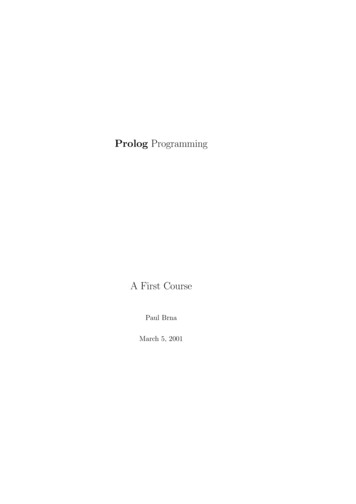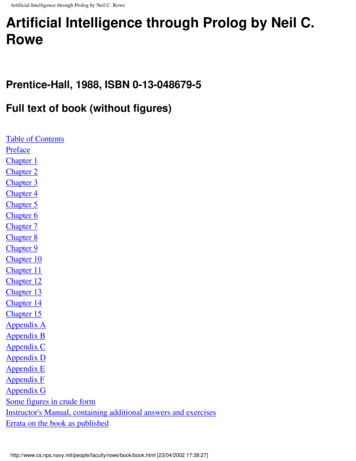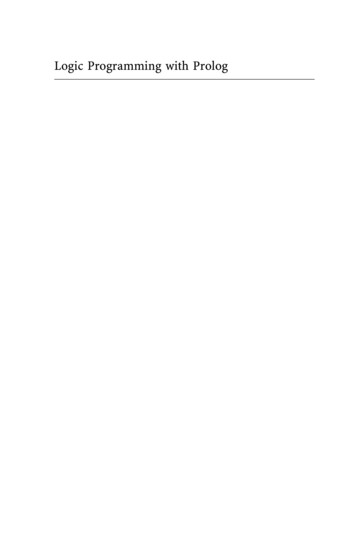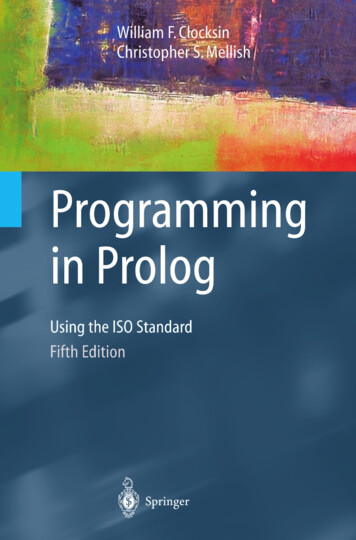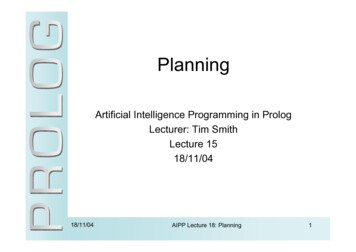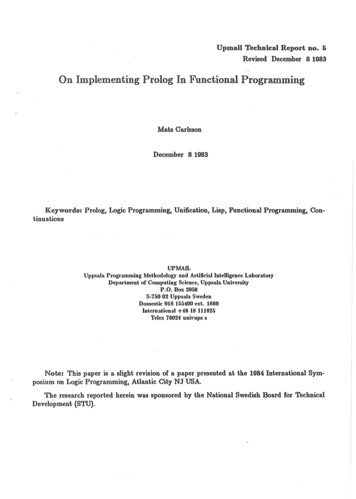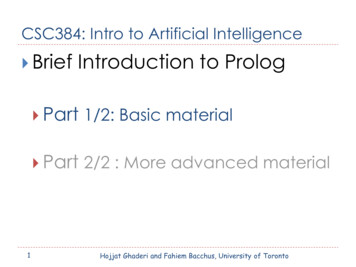
Transcription
CSC384: Intro to Artificial Intelligence BriefIntroduction to Prolog Part 1/2: Basic material Part 2/2 : More advanced material1Hojjat Ghaderi and Fahiem Bacchus, University of Toronto
CSC384: Intro to Artificial Intelligence Resources2 Check the course website for several onlinetutorials and examples. There is also a comprehensive textbook:Prolog Programming for Artificial Intelligenceby Ivan Bratko.Hojjat Ghaderi and Fahiem Bacchus, University of Toronto
What‟s Prolog? Prolog is a language that is useful for doingsymbolic and logic-based computation. It‟s declarative: very different from imperativestyle programming like Java, C , Python, A program is partly like a database but muchmore powerful since we can also have generalrules to infer new facts! A Prolog interpreter can follow these facts/rulesand answer queries by sophisticated search. Ready for a quick ride? Buckle up!3Hojjat Ghaderi and Fahiem Bacchus, University of Toronto
What‟s Prolog? Let‟s do a test drive!Here is a simple Prolog program saved in a file named family.plmale(albert).%a fact stating albert is a malemale(edward).female(alice).%a fact stating alice is a femalefemale(victoria).parent(albert,edward).%a fact: albert is parent of edwardparent(victoria,edward).father(X,Y) :%a rule: X is father of Y if X if a male parent of Yparent(X,Y), male(X). %body of above rule, can be on same line.mother(X,Y) :- parent(X,Y), female(X). %a similar rule for X being mother of Y 4A fact/rule (statement) ends with “.” and white space ignoredread :- after rule head as “if”. Read comma in body as “and”Comment a line with % or use /* */ for multi-line commentsOk, how do we run this program? What does it do?Hojjat Ghaderi and Fahiem Bacchus, University of Toronto
Running Prolog There are many Prolog interpreters.SWI is the one we use on CDF. Type prolog in command line:skywolf: % prologWelcome to SWI-Prolog (Multi-threaded, 32 bits, Version 5.6.58)Copyright (c) 1990-2008 University of Amsterdam.SWI-Prolog comes with ABSOLUTELY NO WARRANTY. This is free software,and you are welcome to redistribute it under certain conditions.Please visit http://www.swi-prolog.org for details.For help, use ?- help(Topic). or ?- apropos(Word).?- this is the prompt. You can load you program and ask queries.?- consult(family).%loading our file. We can use full-name with quotation ‘family.pl’% family compiled 0.00 sec, 2,552 bytes %this is the result of loadingtrue.%true means loading file was successful?- halt.% alternatively, we could have used [‘family.pl’]. to load our file.%exiting SWI!skywolf: %5Hojjat Ghaderi and Fahiem Bacchus, University of Toronto
But what can we do with our program?We can ask queries after loading our program:male(albert). %this is our family.pl program?-male(albert).male(edward).Yes. %the above was ).parent(albert,edward).No. %the above was X,Y):- parent(X,Y), male(X).mother(X,Y):- parent(X,Y), female(X).No.?-male(X). %X is a variable, we are asking “who is male?”X albert;%right! now type semicolon to ask for more answers.X edward;No%no more answers?-father(F,C). %F & C are variables, we are asking “who is father of whom”F albert, C edward; %this is awesome! How did Prolog get this?No6Hojjat Ghaderi and Fahiem Bacchus, University of Toronto
What to learn? Your first impression? It‟s very different from Java, Python,and C! We first need to learn the Prolog Syntax, similar to learningany other language! To learn how to write programs and ask queries, we alsoneed to understand how a Prolog interpreter operates tofind answers to our queries. Finally, you will need to learn how to write more efficientprograms, how to use Negation as Failure, and how tocontrol the Prolog search mechanism using cut.7Hojjat Ghaderi and Fahiem Bacchus, University of Toronto
Syntax of PrologTermsPredicatesFacts and RulesProgramsQueries 8Hojjat Ghaderi and Fahiem Bacchus, University of Toronto
Syntax of Prolog: TermsConstants: Identifiers Numbers sequences of letters, digits, or underscore “ ” that start withlower case letters.mary, anna, x25, x 25, alpha beta1.001, 2, 3.03Strings enclosed in single quotes „Mary‟, „1.01‟, „string‟ Note can start with upper case letter, or can be a numbernow treated as a string.Variables Sequence of letters digits or underscore that start with anupper case letter or the underscore. 9x, Anna, Successor State,Undescore by itself is the special “anonymous” variable.Hojjat Ghaderi and Fahiem Bacchus, University of Toronto
Syntax of Prolog: TermsConstants:VariablesStructures (like function applications) identifier (Term1, ., Termk) Note that the definition is recursive. So each termcan itself be a structure 10date(1, may, 1983)point(X, Y, Z)date( (0,1), may, (1900,-(183,100)))Structures can be represented as a treeHojjat Ghaderi and Fahiem Bacchus, University of Toronto
Syntax of Prolog: TermsStructures as trees date( (0,1), may, (1900,-(183,100)))date 0 may11900 0111Hojjat Ghaderi and Fahiem Bacchus, University of Toronto
Syntax of Prolog: TermsStructures Rather than represent the arithmetic term (1900,-(183,100))in this format (prefix form) Prolog will represent it inmore standard infix form1900 (183 – 100) Note that since Prolog is a symbolic language it willtreat this arithmetic expression as a symbol. That is, itwill not evaluate this expression to 1983.To force the evaluation we use “is”X is 1900 (183 – 100). 12Hojjat Ghaderi and Fahiem Bacchus, University of Toronto
Syntax of Prolog: Lists as special terms Lists are a very useful data structure in Prolog.Lists are structured terms represented in a special way. [a,b,c,d] 13This is actually the structured term[a [c [b [d []]]]]Where [] is a special constant the empty list.Each list is thus of the form [ head rest of list ] head an element of the list (not necessarily a list itself). rest of list is a list (a sub-list).also, [a,b,c,d] [a [b,c,d]] [a,b [c,d]] [a,b,c [d]]List elements can be any term! For example the list[a, f(a), 2, 3 5, point(X,1.5,Z)] contains 5 elements.As we will see, this structure has important implicationswhen it comes to matching variables against lists!Hojjat Ghaderi and Fahiem Bacchus, University of Toronto
Syntax of Prolog: PredicatesPredicates are syntactically identical tostructured terms identifier (Term1, ., Termk) 14elephant(mary)taller than(john, fred)Hojjat Ghaderi and Fahiem Bacchus, University of Toronto
Syntax of Prolog: Facts and RulesA prolog program consists of a collection of factsand rules.A fact is a predicate terminated by a period “.” identifier (Term1, ., Termk).Facts make assertions: elephant(mary).taller than(john, fred).parent(X). 15Mary is an elephant.John is taller than Fred.Everyone is a parent!Note that X is a variable. X can take on any term as its valueso this fact asserts that for every value of X, “parent” is true.Hojjat Ghaderi and Fahiem Bacchus, University of Toronto
Syntax of Prolog: Facts and Rules RulespredicateH :- predicate1, ., predicatek. First predicate is RULE HEAD. Terminated by a period.Rules encode ways of deriving or computing a new fact. animal(X) :- elephant(X). taller than(X,Y) :- height(X,H1), height(Y,H2), H1 H2. We can show that X is taller than Jane if we can show that H1 is theheight of X and that H1 is greater than 165father(X,Y) :- parent(X,Y), male(X). 16We can show that X is taller than Y if we can show that H1 is theheight of X, and H2 is the height of Y, and H1 is greater than H2.taller than(X,Jane) :- height(X,H1), H1 165 We can show that X is an animal if we can show that it is anelephant.We can show that X is a father of Y if we can show that X is a parentof Y and that X is male.Hojjat Ghaderi and Fahiem Bacchus, University of Toronto
Operation Of Prolog A query is a sequence of predicates predicate1, predicate2, ., predicatekProlog tries to prove that this sequence ofpredicates is true using the facts and rules in theProlog Program.In proving the sequence it performs thecomputation you want.17Hojjat Ghaderi and Fahiem Bacchus, University of Toronto
.animal(fred) :- elephant(fred).animal(mary) :- elephant(mary).animal(joe) :- elephant(joe).QUERYanimal(fred), animal(mary), animal(joe)18Hojjat Ghaderi and Fahiem Bacchus, University of Toronto
OperationStarting with the first predicate P1 of the queryProlog examines the program from TOP to BOTTOM.It finds the first RULE HEAD or FACT that matches P1Then it replaces P1 with the RULE BODY.If P1 matched a FACT, we can think of FACTs as havingempty bodies (so P1 is simply removed).The result is a new query.E.g.P1 :- Q1, Q2, Q3QUERY P1, P2, P3P1 matches with ruleNew QUERY Q1, Q2, Q3, P2, P319Hojjat Ghaderi and Fahiem Bacchus, University of Toronto
.animal(fred) :- elephant(fred).animal(mary) :- elephant(mary).animal(joe) :- elephant(joe).QUERYanimal(fred), animal(mary), animal(joe)1. elephant(fred), animal(mary), animal(joe)2. animal(mary),animal(joe)3. elephant(mary), animal(joe)4. animal(joe)5. elephant(joe)6. EMPTY QUERY20Hojjat Ghaderi and Fahiem Bacchus, University of Toronto
Operation If this process reduces the query to the emptyquery, Prolog returns “yes”.However, during this process each predicate inthe query might match more than one fact orrule head. 21Prolog always choose the first match it finds. Then ifthe resulting query reduction did not succeed (i.e.,we hit a predicate in the query that does not matchany rule head of fact), Prolog backtracks and tries anew match.Hojjat Ghaderi and Fahiem Bacchus, University of Toronto
Exampleant eater(fred).animal(fred) :- elephant(fred).animal(fred) :- ant ed).FAIL BACKTRACK.ant eater(fred).EMPTY QUERYHojjat Ghaderi and Fahiem Bacchus, University of Toronto
Operation Backtracking can occur at every stage as thequery is processed.p(1) :- a(1).p(1) :- b(1).a(1) :- c(1).c(1) :- d(1).c(1) :- d(2).b(1) :- e(1).e(1).d(3).Query: p(1)23p(1)a(1)c(1)d(1)b(1)e(1)d(2)Hojjat Ghaderi and Fahiem Bacchus, University of Torontod(3)
Operation With backtracking we can get more answers byusing “;”p(1) :- a(1).p(1)p(1) :- b(1).a(1) :- c(1).a(1)b(1)c(1) :- d(1).c(1) :- d(2).b(1) :- e(1).c(1)e(1)d(3)b(1) :- d(3).e(1).d(1)d(2)d(3).Query: p(1)24Hojjat Ghaderi and Fahiem Bacchus, University of Toronto
Variables and Matching Variables allow us to 25Compute more than yes/no answersCompress the ).animal(fred) :- elephant(fred).animal(mary) :- elephant(mary).animal(joe) :- elephant(joe).The three rules can be replaced by the single ruleanimal(X) :- elephant(X).When matching queries against rule heads (of facts)variables allow many additional matches.Hojjat Ghaderi and Fahiem Bacchus, University of Toronto
.animal(X) :- elephant(X).QUERYanimal(fred), animal(mary), animal(joe)1. X fred, elephant(X), animal(mary), animal(joe)2. animal(mary),animal(joe)3. X mary, elephant(X), animal(joe)4. animal(joe)5. X joe, elephant(X)6. EMPTY QUERY26Hojjat Ghaderi and Fahiem Bacchus, University of Toronto
Operation with Variables Queries are processed as before (via rule andfact matching and backtracking), but now wecan use variables to help us match rule heads orfacts.A query predicate matches a rule head or fact(either one with variables) if 27The predicate name much match. So elephant(X)can match elephant(fred), but can never matchant eater(fred).Once the predicates names the arity of thepredicates much match (number of terms). Sofoo(X,Y) can match foo(ann,mary), but cannotmatch foo(ann) or foo(ann,mary,fred).Hojjat Ghaderi and Fahiem Bacchus, University of Toronto
Operation A query predicate matches a rule head or fact(either one with variables) if 28If the predicate names and arities match then eachof the k-terms much match. So for foo(t1, t2, t3) tomatch foo(s1, s2, s3) we must have that t1 matchess1, t2 matches s2, and t3 matches t3.During this matching process we might have to“bind” some of the variables to make the termsmatch.These bindings are then passed on into the newquery (consisting of the rule body and the left overquery predicates).Hojjat Ghaderi and Fahiem Bacchus, University of Toronto
Variable Matching (Unification) Two terms (with variables match if): If both are constants (identifiers, numbers, or strings)and are identical.If one or both are bound variables then they matchif what the variables are bound to match. 29X and mary where X is bound to the value mary will match.X and Y where X is bound to mary and Y is bound to marywill match,X and ann where X is bound to mary will not match.Hojjat Ghaderi and Fahiem Bacchus, University of Toronto
Variable Matching (Unification) If one of the terms is an unbound variable thenthey match AND we bind the variable to theterm. 30X and mary where X is unbound match and make Xbound to mary.X and Y where X is unbound and Y is bound to marymatch and make X bound to mary.X and Y where both X and Y are unbound matchand make X bound to Y (or vice versa).Hojjat Ghaderi and Fahiem Bacchus, University of Toronto
Variable Matching (Unification) If the two terms are structurest f(t1, t2, ., tk)s g(s1, s2, ., sn)Then these two terms match if the identifiers “f” and “g” are identical.They both have identical arity (k n)Each of the terms ti, si match (recursively).E.g. date(X, may, 1900) and date(3, may, Y) match and make X boundto 3 and Y bound to 1900.equal(2 2, 3 1) and equal(X Y, Z) match and make X bound to1, Y bound to 2, and Z bound to “3 1”. date(f(X,a), may, g(a,b)) and date(Z, may, g(Y,Q)) match andmake Z bound to “f(X,a)”, Y bound to a, and Q bound to b. Note that to then evaluate Z by using “is”.Note we can bind a variable to a term containing another variable!The predicate “ ” shows what Prolog unifies!31Hojjat Ghaderi and Fahiem Bacchus, University of Toronto
Unification Examples Which of the following are unifiable?32Term1Term 2Bindings if unifiableXf(a,b)X f(a,b)f(X,a)g(X,a)32 1book(X,1)book(Z)[1,2,3][X Y][a,b,X][Y [3,4]][a X][X Y]X(a,b)f(Z,Y)[X Y Z][a,b,c,d]No! use is if want 3X 1, Y [2,3]X a Y aimproper listX a. Y b, Z [c,d]Hojjat Ghaderi and Fahiem Bacchus, University of Toronto
Solving Queries How Prolog works: UnificationGoal-Directed ReasoningRule-OrderingDFS and backtrackingWhen given a query Q q1, q2, , qn Prologperforms a search in an attempt to solve thisquery. The search can be specified as follows33Hojjat Ghaderi and Fahiem Bacchus, University of Toronto
Details of Solving Queries by Prolog//note: variable bindings are global to the procedure “evaluate”bool evaluate(Query Q)if Q is emptySUCCEED: print bindings of all variables in original queryif user wants more solutions (i.e. enters ';') return FALSEelse return TRUEelseremove first predicate from Q, let q1 be this predicatefor each rule R h :- r1, r2, ., rj in the program inthe order they appear in the fileif(h unifies with q1 (i.e., the head of R unifies with q1))put each ri into the query Q so that if the Q was originally(q1, q2, , qk) it now becomes (r1, r2, , rj, q2, qk)NOTE: rule‟s body is put in front of previous query predicates.NOTE: also some of the variables in the ri‟s and q2 qk mightnow be bound because of unifying h with q1if (evaluate(Q) ) //recursive call on updated Qreturn. //succeeded and printed bindings in recusive call.34Hojjat Ghaderi and Fahiem Bacchus, University of Toronto
Computing with Queriesfor each rule R h :- r1, r2, ., rj in the program inthe order the rules appear in the prolog fileif(h unifies with q1 (i.e., the head of R unifies with q1))put each ri into the query Q so that if the Q was originally(q1, q2, , qk) it now becomes (r1, r2, , rj, q2, qk)NOTE: rule‟s body is put in front of previous query predicates.NOTE: also some of the variables in the ri‟s and q2 qk mightnow be bound because of unifying h with q1if(evaluate(Q) )return. //succeeded and printed bindings in recusive call.elseUNDO all changes to the variable bindings that arose fromunifying h and q1end for//NOTE. If R‟s head fails to unify with q1 we move on to try thenext rule in the program. If R‟s head did unify but unableto solve the new query recursively, we also move on totry the next rule after first undoing the variable bindings.35Hojjat Ghaderi and Fahiem Bacchus, University of Toronto
Computing with Queriesend for//NOTE. If R‟s head fails to unify with q1 we move on to try thenext rule in the program. If R‟s head did unify but unableto solve the new query recursively, we also move on totry the next rule after first undoing the variable bindings.return FALSE//at this point we cannot solve q1, so we fail. This failure willunroll the recursion and a higher level recursion with then trydifferent rule for the predicate it is working on.36Hojjat Ghaderi and Fahiem Bacchus, University of Toronto
Query Answering is Depth First SearchThis procedure operates like a depth-first search, where the order ofthe search depends on the order of the rules and predicates in therule bodies. When Prolog backtracks, it undoes the bindings it did before. Exercise: try the following queries on family.pl:parent(P,C)father(F,C).[if you can, use the interactive SWI with graphical debugger]37Hojjat Ghaderi and Fahiem Bacchus, University of Toronto
Another Example of Query Answering Routefinding in in a directed acyclic path(X,Y) :- path(X,Z), edge(Z,Y).path(X,Y) :- edge(X,Y). Theabove is problematic. Why? Here is the correct solution:path(X,Y) :- edge(X,Y).path(X,Y) :- edge(X,Z), path(Z,Y).38Hojjat Ghaderi and Fahiem Bacchus, University of Torontoe
Search Tree for Path PredicateHere is the th(X,Y) :- edge(X,Y).path(X,Y) :- edge(X,Z), un SWI interactively to see this in action.]What if the graph is undirected? Simple:undirEdge(X,Y):- edge(X,Y).undirEdge(X,Y):- edge(Y,X).then replace edge predicate by undirEdge in the definition of path.39Hojjat Ghaderi and Fahiem Bacchus, University of Toronto
Notes on Prolog Variables Prolog variables do not operate like otherprogramming languages! You cannot changethe value of variables, once they are bound toa value they remain bound. However: If a variable binding contains another variable that othervariable can be bound thus altering the originalvariable‟s value, e.g.X f(a, g(Y)), Y b X is bound to f(a, g(b)); Y is bound to b 40Final answers can be computed by passing thevariable‟s value on to a new variable. E.g.,X a, Y b, Z [X,Y] X is bound to a, Y is bound tob, and Z is bound to [a,b].Hojjat Ghaderi and Fahiem Bacchus, University of Toronto
List Processing in Prolog Much of prolog‟s computation is organized around lists. Two keythings we do with a list is iterate over them and build new ones. E.g. checking membership: member(X,Y) X is a member of list Y.member(X,[X ]).member(X,[ T]):- member(X,T).What if we define member like this:member(X,[X ]).member(X,[Y T]):- X \ Y, member(X,T).what is the result of member(X,[a,b,c,d])? E.g. building a list of integers in range [i, j].build(from, to, NewList)build (I,J,[ ]) :- I J.build (I,J,[I Rest]) :- I J, N is I 1,build(N,J,Rest).41Hojjat Ghaderi and Fahiem Bacchus, University of Toronto
List Processing in Prolog continue Computing the size of a list: size(List, ListSize)size([],0).size([ T],N) :- size(T,N1), N is N1 1. Computing the sum of a list of nums: sumlist(List, Sum)sumlist([],0)sumlist([H T],N) :- sumlist(T,N1), N is N1 H. Exercise: implement append(L1,L2, L3) which holds if L3 isthe result of appending list L1 and L2. For 42Hojjat Ghaderi and Fahiem Bacchus, University of Toronto
Next Tutorial (Part 2) More advanced material in the next tutorial: Efficient lists processing using accumulators Constructing predicates dynamically (on-the-fly) Cut (controlling how Prolog does the search) Negation as failure (NAF) if-then-else Debugging Prolog programs43Hojjat Ghaderi and Fahiem Bacchus, University of Toronto
CSC384: Intro to Artificial Intelligence Resources Check the course website for several online tutorials and examples. There is also a comprehensive textbook: Prolog Programming

